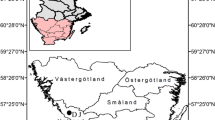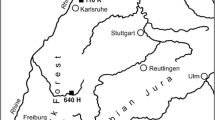Abstract
European beech (Fagus sylvatica L.) covers a large area mainly in the colline and montane ranges in Europe, and a drier and warmer climate, as expected for the coming decades, is likely to alter its distribution. So far, an altitudinal shift has been projected using a variety of modelling approaches. However, we lack knowledge about the climatic and edaphic factors that control the growth and competitive behaviour of beech at its dry distribution limit. We applied and further developed dendroecological methods to study the drought response and sensitivity pattern of beech at sites with different moisture regimes. We compared three pairs of sites from different geographical regions near the dry distribution limit of beech in Switzerland, consisting of a dry and mesic site each. Radial growth differed between mesic and dry sites, in that average ring-width at mesic sites was around double the width at dry sites. For the whole study period (1930–2006), the sites with the lowest available soil water capacity (AWC) were found to respond most sensitively to drought. However, in recent years, sites with higher AWC have shown increasing drought sensitivity, i.e. they have responded even more strongly to drought than the dry sites. This change in sensitivity corresponds to a seasonal shift in drought response at mesic sites, with a change in the months showing significant drought response in all three studied regions compared with the past. Even though dry sites generally displayed a larger number of negative pointer years than mesic sites, it appears that the frequency of pointer years has increased at mesic sites, i.e. they have become more sensitive particularly in the last quarter of the twentieth century. Yet, the frequency of pointer years at the dry sites has remained fairly constant. These results indicate that beech trees near their dry distribution limit are adapted to extreme conditions already, while changes in the growth patterns of beech under mesic conditions have to be expected.



Similar content being viewed by others
References
Andreu L, Gutierrez E, Macias M, Ribas M, Bosch O, Camarero JJ (2007) Climate increases regional tree-growth variability in Iberian pine forests. Glob Change Biol 13:804–815
Beck W, Müller J (2006) Impact of heat and drought on tree and stand vitality—dendroecological methods and first results from level II—plots in southern Germany. Schriften aus der Forstlichen Fakultät der Universität Göttingen und der Nordwestdeutschen Forstlichen Versuchsanstalt 142:120–127
Bigler C, Bugmann H (2004) Predicting the time of tree death using dendrochronological data. Ecol Appl 14:902–914
Biondi F, Qeadan F (2008) A theory-driven approach to tree-ring standardization: defining the biological trend from expected basal area increment. Tree Ring Res 64:81–96
Biondi F, Waikul K (2004) DENDROCLIM2002: a C++ program for statistical calibration of climate signals in tree-ring chronologies. Comput Geosci 30:303–311
Bodenkunde AG (1982) Bodenkundliche Kartieranleitung. Schweizerbart, Stuttgart, p 331
Brändli U-B (1998) Die häufigsten Waldbäume der Schweiz. Ergebnisse aus dem Landesforstinventar 1983–85: Verbreitung, Standort und Häufigkeit von 30 Baumarten. Eidg. Forschungsanstald für Wald, Schnee und Landschaft, Birmensdorf, p 279
Brzeziecki B, Kienast F, Wildi O (1995) Modeling potential impacts of climate-change on the spatial distribution of zonal forest communities in Switzerland. J Veg Sci 6:257–268
Bugmann H (1997) Sensitivity of forests in the European Alps to future climatic change. Clim Res 8:35–44
Bugmann H, Pfister C (2000) Impacts of interannual climate variability on past and future forest composition. Reg Environ Change 1:112–125
Chauchard S, Carcaillet C, Guibal F (2007) Patterns of land-use abandonment control tree-recruitment and forest dynamics in Mediterranean mountains. Ecosystems 10:936–948
Ciais P, Reichstein M, Viovy N, Granier A, Ogee J, Allard V, Aubinet M, Buchmann N, Bernhofer C, Carrara A, Chevallier F, De Noblet N, Friend AD, Friedlingstein P, Grunwald T, Heinesch B, Keronen P, Knohl A, Krinner G, Loustau D, Manca G, Matteucci G, Miglietta F, Ourcival JM, Papale D, Pilegaard K, Rambal S, Seufert G, Soussana JF, Sanz MJ, Schulze ED, Vesala T, Valentini R (2005) Europe-wide reduction in primary productivity caused by the heat and drought in 2003. Nature 437:529–533
Cook ER (1985) A time series analysis approach to tree-ring standardization. Department of Geosciences. University of Arizona, Tucson, Arizona, USA, p 171
Cook ER, Pederson N (2011) Uncertainty, emergence, and statistics in dendrochronology. In: Hughes MK, Swetnam TW, Diaz HF (eds) Dendroclimatology. Developments in paleoenvironmental research, vol 11. Springer, Berlin, pp 77–112
Cropper JP (1979) Tree-ring skeleton plotting by computer. Tree Ring Bull 39:47–59
Defila C, Clot B (2001) Phytophenological trends in Switzerland. Int J Biometeorol 45:203–207
Di Filippo A, Biondi F, Cufar K, de Luis M, Grabner M, Maugeri M, Presutti Saba E, Schirone B, Piovesan G (2007) Bioclimatology of beech (Fagus sylvatica L.) in the Eastern Alps: spatial and altitudinal climatic signals identified through a tree-ring network. J Biogeogr 34:1873–1892
Fekedulegn D, Hicks RR, Colbert JJ (2003) Influence of topographic aspect, precipitation and drought on radial growth of four major tree species in an Appalachian watershed. For Ecol Manage 177:409–425
Friedrichs D, Trouet V, Büntgen U, Frank D, Esper J, Neuwirth B, Löffler J (2009) Species-specific climate sensitivity of tree growth in Central-West Germany. Trees 23:729–739
Fritts HC (1971) Multivariate techniques for calibrating time series used to reconstruct anomalies in paleoclimate. Bull Am Meteorol Soc 52:218
Fritts HC (1976) Tree rings and climate. Academic Press, London
Gärtner S, Reif A, Xystrakis F, Sayer U, Bendagha N, Matzarakis A (2008) The drought tolerance limit of Fagus sylvatica forest on limestone in southwestern Germany. J Veg Sci 19:757–768
Gessler A, Keitel C, Kreuzwieser J, Matyssek R, Seiler W, Rennenberg H (2007) Potential risks for European beech (Fagus sylvatica L.) in a changing climate. Trees 21:1–11
Holmes RL (1994) Computer-assisted quality control in tree-ring dating and measurement. Tree Ring Bull 43:69–78
Jansma E (1995) RemembeRINGs: the development and application of local and regional tree-ring chronologies of oak for the purposes of archaeological and historical research in the Netherlands. Dissertation, Universiteit van Amsterdam. Rijksdienst voor het Oudheidkundig Bodemonderzoek. Amersfoort
Jolly WM, Dobbertin M, Zimmermann NE, Reichstein M (2005) Divergent vegetation growth responses to the 2003 heat wave in the Swiss Alps. Geophys Res Lett 32:L18409. doi:10.1029/2005GL023252
Kienast F, Schweingruber FH, Bräker OU, Schaer E (1987) Tree-ring studies on conifers along ecological gradients and the potential of single-year analyses. Can J For Res 17:683–696
Lebourgeois F, Breda N, Ulrich E, Granier A (2005) Climate-tree-growth relationships of European beech (Fagus sylvatica L.) in the French Permanent Plot Network (RENECOFOR). Trees 19:385–401
Leuzinger S, Zotz G, Asshoff R, Körner C (2005) Responses of deciduous forest trees to severe drought in Central Europe. Tree Physiol 25:641–650
Menzel A (2000) Trends in phenological phases in Europe between 1951 and 1996. Int J Biometeorol 44:76–81
Menzel A, Sparks TH, Estrella N, Koch E, Aasa A, Ahas R, Alm-Kubler K, Bissolli P, Braslavska O, Briede A, Chmielewski FM, Crepinsek Z, Curnel Y, Dahl A, Defila C, Donnelly A, Filella Y, Jatcza K, Mage F, Mestre A, Nordli O, Penuelas J, Pirinen P, Remisova V, Scheifinger H, Striz M, Susnik A, Van Vliet AJH, Wielgolaski FE, Zach S, Zust A (2006) European phenological response to climate change matches the warming pattern. Glob Change Biol 12:1969–1976
Meyer FD (1999) Pointer years analysis in dendroecology: a comparison of methods. Dendrochronologia 16–17:193–204
OcCC (2007) Klimaänderung und die Schweiz. Erwartete Auswirkungen auf Umwelt, Gesellschaft und Wirtschaft, p 168
Parry ML, Canziani OF, Palutikof JP, van der Linden PJ, Hanson CE (eds) (2007) Contribution of Working Group II to the Fourth Assessment Report of the Intergovernmental Panel on Climate Change. Cambridge University Press, Cambridge, p 976
Penuelas J, Hunt JM, Ogaya R, Jump AS (2008) Twentieth century changes of tree-ring δ13C at the southern range-edge of Fagus sylvatica: increasing water-use efficiency does not avoid the growth decline induced by warming at low altitudes. Glob Change Biol 14:1076–1088
Piovesan G, Biondi F, Bernabei M, Di Filippo A, Schirone B (2005) Spatial and altitudinal bioclimatic zones of the Italian peninsula identified from a beech (Fagus sylvatica L.) tree-ring network. Acta Oecologica 27:197–210
Piovesan G, Biondi F, Di Filippo A, Alessandrini A, Maugeri M (2008) Drought-driven growth reduction in old beech (Fagus sylvatica L.) forests of the central Apennines, Italy. Glob Change Biol 14:1265–1281
Pluess AR, Weber P (2012) Drought-adaptation potential in Fagus sylvatica: linking moisture availability with genetic diversity and dendrochronology. PLoS One 7:e33636. doi:33610.31371/journal.pone.0033636
Pott R (2000) Palaeoclimate and vegetation—long-term vegetation dynamics in central Europe with particular reference to beech. Phytocoenologia 30:285–333
R Development Core Team (2008) R: a language and environment for statistical computing. R Foundation for Statistical Computing, Vienna, Austria. http://cran.r-project.org/
Rasche L, Fahse L, Zingg A, Bugmann H (2012) Enhancing gap model accuracy by modeling dynamic height growth and dynamic maximum tree height. Ecol Model 232:133–143
Rennenberg H, Loreto F, Polle A, Brilli F, Fares S, Beniwal RS, Gessler A (2006) Physiological responses of forest trees to heat and drought. Plant Biol 8:556–571
Rigling A, Waldner PO, Forster T, Bräker OU, Pouttu A (2001) Ecological interpretation of tree-ring width and intraannual density fluctuations in Pinus sylvestris on dry sites in the central Alps and Siberia. Can J For Res 31:18–31
Rigling A, Bräker OU, Schneiter G, Schweingruber F (2002) Intra-annual tree-ring parameters indicating differences in drought stress of Pinus sylvestris forests within the Erico-Pinion in the Valais (Switzerland). Plant Ecol 163:105–121
Scharnweber T, Manthey M, Criegee C, Bauwe A, Schroeder C, Wilmking M (2011) Drought matters—declining precipitation influences growth of Fagus sylvatica L. and Quercus robur L. in north-eastern Germany. For Ecol Manage 262:947–961
Schulman E (1956) Dendroclimatic changes in semiarid America. University of Arizona Press, Tucson
Schweingruber F (1990) Identification, presentation and interpretation of event years and pointer years in dendrochronology. Dendrochronologia 8:9–38
Sykes MT, Prentice IC, Cramer W (1996) A bioclimatic model for the potential distributions of north European tree species under present and future climates. J Biogeogr 23:203–233
Thornton PE, Running SW, White MA (1997) Generating surfaces of daily meteorological variables over large regions of complex terrain. J Hydrol 190:214–251
Turc L (1963) Evaluation des besoins en eau d’irrigation, évapotranspiration potentielle, formulation simplifié et mise à jour. Ann Agron 12:13–49
Weber P, Bugmann H, Rigling A (2007) Radial growth responses to drought of Pinus sylvestris and Quercus pubescens in an inner-Alpine dry valley. J Veg Sci 18:777–792
Weber P, Bugmann H, Fonti P, Rigling A (2008) Using a retrospective dynamic competition index to reconstruct forest succession. For Ecol Manage 254:96–106
Welten M, Sutter R (1982) Verbreitungsatlas der Farn- und Blütenpflanzen der Schweiz. Birkhäuser, Basel, p 716
Wigley TML, Briffa KR, Jones PD (1984) On the average value of correlated time-series, with applications in dendroclimatology and hydrometeorology. J Clim Appl Meteorol 23:201–213
Z’Graggen S (1992) Dendrohistometrisch-klimatologische Untersuchung an Buchen (Fagus silvatica L.). Philosophisch-Naturwissenschaftliche Fakultät, vol. PhD, Universität Basel, Basel, p 167
Zimmermann NE, Bolliger J, Gehrig-Fasel J, Guisan A, Kienast F, Lischke H, Rickebusch S, Wohlgemuth T (2006) Wo wachsen die Bäume in 100 Jahren? Forum für Wissen: 63–71
Zingg A, Brang P (2003) Zuwachs von Buchen nach Trockenjahren. Sterben Buchen wegen der Trockenheit? Wald und Holz 9:44–46
Acknowledgments
We would like to thank Hannes Suter and Daniel Bernet for their help with sampling and measuring tree cores, as well as Roger Köchli, Marco Walser, Pascal Wiesli and Roger Schürmann for their help with the soil pits. DAYMET climate data were provided by Dirk Schmatz. We are grateful to two anonymous referees who provided valuable comments and to Silvia Dingwall who helped with language editing. This work was funded by the Swiss State Secretariat for Education and Research (SER) as part of a project within COST Action E52 on beech genetics (SBF grant No. C07.0113), and by the Swiss Federal Office for the Environment (FOEN).
Author information
Authors and Affiliations
Corresponding author
Additional information
Communicated by H. Rennenberg.
Rights and permissions
About this article
Cite this article
Weber, P., Bugmann, H., Pluess, A.R. et al. Drought response and changing mean sensitivity of European beech close to the dry distribution limit. Trees 27, 171–181 (2013). https://doi.org/10.1007/s00468-012-0786-4
Received:
Revised:
Accepted:
Published:
Issue Date:
DOI: https://doi.org/10.1007/s00468-012-0786-4




